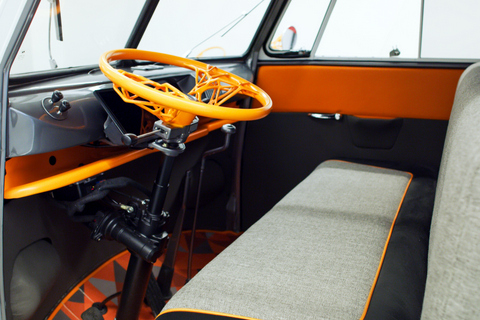VW Lab Marks 20 Years of Progress
“It was 20 years ago today….”–The Beatles, Sgt. Pepper’s Lonely Hearts Club Band
Volkswagen, the maker of the other Beetles, was one of the early automotive pioneers dipping its toe in the world of chips and software in Northern California, opening its Silicon Valley outpost in 1999. What started out as a scouting expedition for tech has evolved into the newly named Volkswagen Innovation & Engineering Center California (IECC).

VW looks back but also looks forward as maybe only Volkswagen can do, taking one of its iconic microbuses, converting it to electric drive and stuffing it full of high-tech goodies to showcase the Belmont, Calif. Lab’s mission. The Type 20, a play on the original Type 2 microbus, embodies the type of leap forward expected to come from the hotbed of world technology.
As Nikolai Reimer (executive director of IECC) explained, VW’s heritage is building emotional cars like the Type 2 and the original Beetle, but the Silicon Valley outpost embraced the “endless passion to reinvent ourselves,” delving into projects of autonomous vehicles for the DARPA Challenge, new infotainment experiences and advanced manufacturing technologies.
Tech-Packed Steel
While the IECC shares its role in Volkswagen innovation with two other labs around the world (in Germany and China), it’s hard to imagine another lab coming up with the Type 20. The old microbus’ connection with California surf and sun is legendary, but also it’s hard to imagine another location where the VW team could have both found a 1962 Type 2 11-window van in restorable condition and also found a shop specializing in converting this type of vehicle to a full electric machine.

VW took the first generation microbus to Electric GT in Southern California for a transplant. Swapping out the 42-horsepower flat four for a 15-kilowatt (kW) motor backed with a 10-kW battery, producing 120 hp and 173 pounds-feet of torque. Just for fun, a custom-designed active pneumatic suspension adjusts the vehicle ride height through a software program. While it’s a lot faster than the original and definitely handles better, the real-world range for this show piece is less than 50 miles.
The real tech comes into play as you approach the Type 20. It has a real-time facial recognition system that greets you as you approach, spotting you with a 720p wide-angle camera lens in the driver’s side second window and completing the recognition process using Sensory SDK software running on a prototype Nvidia Jetson TX2 package.

Inside, the Type 20 has three zones of microphones that can receive and respond to natural language commands. You know the car is listening if you’re outside because the VW logo will light up or the lights will blink. The “dash” for the car is a Looking Glass II holographic display that generates 3D images without the need for specialized glasses.
Future Tech Becoming Real
Incorporated into the accelerated six-month development timeline for the Type 20 was the use of generative design, a software process that uses artificial intelligence to take a design from concept to reality by balancing physical parameters like required strength and packaging constraints with weight reduction goals and unique designs. The car’s wild custom wheels, organic shaped rearview mirror supports and interior support elements were designed through this process.

In reality, the Type 20 is the tip of the iceberg at IECC, which has an autonomous school bus concept on display; parts for Lamborghinis produced through an additive manufacturing process; virtual reality headsets for interior design work; and predictive navigation software developed there that is now available in production Audis.
With the I.D. Buzz reincarnation of the microbus as an EV coming in a few years, we’d expect more of IECC’s technology research to show up inside when it goes on sale.
Type 20 video below (it runs!).
